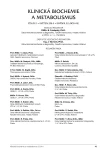Risk factors of Asymptomatic (Smoldering) Multiple Myeloma
Authors:
K. Machálková; V. Maisnar
Authors‘ workplace:
IV. interní hematologická klinika, Fakultní nemocnice a Lékařská fakulta UK, Hradec Králové
Published in:
Klin. Biochem. Metab., 22 (43), 2014, No. 2, p. 70-73
Overview
Smoldering multiple myeloma (SMM) is plasma cell dyscrasia that bridges the gap between monoclonal gammopathy of undetermined significance (MGUS) and active multiple myeloma. In comparison to MGUS is generally the risk of progression to symptomatic myeloma much higher. The current standard of care is not to treat until progression to symptomatic disease occurs. SMM is divided in subgroups with different risk of progression that could be identified on various risk factors. In future high-risk patients should be targeted for early treatment, especially ultra-high risk subgroup with risk of progression in 2 years.
Key words:
Smoldering multiple myeloma – risk factors - treatment.
Sources
1. The International Myeloma Working Group. Criteria for the classification of monoclonal gammopathies, multiple myeloma and related disorders. Br. J. Haematol. 2003, 121(5), p. 749–57.
2. Blade, J., Dimopoulos, M., Rosinol, L., Rajkumar, S. V., Kyle, R. A. Smoldering (asymptomatic) multiple myeloma: current diagnostic criteria, new predictors of outcome, and follow-up recommendations. J Clin. Oncol. 2010, 28(4), p. 690–7.
3. Kyle, R. A., Remstein, E. D., Therneau, T. M., Dispenzieri, A., Kurtin, P. J., Hodnefield, J. M. et al. Clinical course and prognosis of smoldering (asympto-matic) multiple myeloma. N Engl. J. Med. 2007, 356(25), p. 2582–90.
4. Rajkumar, S. V., Larson, D., Kyle, R. A. Diagnosis of smoldering multiple myeloma. N Engl. J. Med. 2011, 365(5), p. 474–5.
5. Rosinol, L., Blade, J., Esteve, J., Aymerich, M., Rozman, M., Montoto, S. et al. Smoldering multiple myeloma: natural history and recognition of an evolving type. Br. J. Haematol. 2003,123(4), p. 631–6.
6. Dispenzieri, A., Kyle, R. A., Katzmann, J. A., Therneau, T. M., Larson, D., Benson, J. et al. Immunoglobulin free light chain ratio is an independent risk factor for progression of smoldering (asymptomatic) multiple myeloma. Blood. 2008, 111(2), p. 785–9.
7. Larsen, J. T., Kumar, S. K., Dispenzieri, A., Kyle, R. A., Katzmann, J. A., Rajkumar, S. V. Serum free light chain ratio as a biomarker for high-risk smoldering multiple myeloma. Leukemia. 2013, 27(4), p. 941–6.
8. Perez-Persona, E., Vidriales, M. B., Mateo, G., Garcia-Sanz, R., Mateos, M. V., De Coca, A. G. et al. New criteria to identify risk of progression in monoclonal gammopathy of uncertain significance and smoldering multiple myeloma based on multiparameter flow cyto-metry analysis of bone marrow plasma cells. Blood. 2007, 110(7), p. 2586–92.
9. Perez-Persona, E., Mateo, G., Garcia-Sanz, R., Mateos, M. V., De Las Heras, N., De Coca, A. G. et al. Risk of progression in smouldering myeloma and monoclonal gammopathies of unknown significance: comparative analysis of the evolution of monoclonal component and multiparameter flow cytometry of bone marrow plasma cells. Br. J. Haematol. 2010, 148(1), p. 110–4.
10. Rajkumar, S. V., Gupta, V., Fonseca, R., Dispenzieri, A., Gonsalves, W. I., Larson, D. et al. Leukemia: Impact of primary molecular cytogenetic abnormalities and risk of progression in smoldering multiple myeloma, 2013.
11. Bianchi, G., Kyle, R. A., Larson, D. R., Witzig, T. E., Kumar, S., Dispenzieri, A. et al. High levels of peripheral blood circulating plasma cells as a specific risk factor for progression of smoldering multiple myeloma. Leukemia. 2013, 27(3), p. 680–5.
12. Hillengass, J., Kilk, K., Listl, K., Hielscher, T., Neben, K., Hose, D. et al. Over 30 % of Smoldering Myeloma Patients Have Tumor Cell Bone Marrow Infiltration Patterns Similar to Multiple Myeloma: A Large (n=544) Clinical Study Using Whole-Body MRI. ASH Annual Meeting Abstracts. 2012, 120(21), p. 2911.
13. Hillengass, J., Fechtner, K., Weber, M. A., Bauerle, T., Ayyaz, S., Heiss, C. et al. Prognostic significance of focal lesions in whole-body magnetic resonance imaging in patients with asymptomatic multiple myeloma. J Clin. Oncol. 2010, 28(9), p. 1606–10.
14. Katzmann, J., Clark, R., Dispenzieri, A. et al. Isotype specific heavy/light chain (HLC) supression as predictor of myeloma development in monoclonal gammopathy of undetermined significance (MGUS). Blood. 2009, 114, S1788
15. Mateos, M. V., Hernández, M. T., Giraldo, P., De La Rubia, J., De Arriba, F., López-Corral, L. et al. Lenalidomide plus Dexamethasone for High-Risk Smolde-ring Multiple Myeloma. N. Engl. J. Med. 2013, 369, p. 438–47.
16. Mateos, M. V., San Miguel, J. F. et. al. New Approaches to Smoldering Myeloma. Curr. Hematol. Malig. Rep. 2013, 8, p. 270-276
Labels
Clinical biochemistry Nuclear medicine Nutritive therapistArticle was published in
Clinical Biochemistry and Metabolism

2014 Issue 2
Most read in this issue
- Clinical Problems of IgM Monoclonal Gammapathies
- Risk factors of Asymptomatic (Smoldering) Multiple Myeloma
- The Standard of Analytical Quality of Glucometers
- Diagnosis and stratification of systemic AL amyloidosis in the light of the 2013 Czech Myeloma Group recommendation
